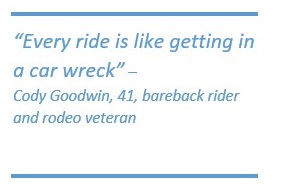While the Houston Livestock Show and Rodeo has come and gone, the rodeo athletes who kept us captivated as they rode, roped and wrangled their way across the arena for the duration are on to a new city – and not even half way through their rodeo season.
The life of a rodeo athlete, many true cowboys at heart, is one of unyielding dedication and physicality.
Those who have participated since youth in rodeo events have built both strengths and vulnerabilities to the ongoing rigors of rodeo life. Proper mental and physical conditioning are key in avoiding serious injury.
While many of the injuries commonly associated with these athletes include concussions and fractures, others are the result of ongoing strain placed on the same limbs, ligaments and joints day in and day out for months at a time.
Many rodeo athletes begin in their teens, tie-down roping calves before progressing to adult wrangler, bull or bare back rider. The years of hand and upper extremity strain predisposes this athlete to tendonitis in the hand, wrist, elbow and shoulder. Known as a repetitive stress or overuse condition, without proper treatment it can cause chronic inflammation, joint instability and eventually the early onset of arthritis.
Recognizing early signs of tendinopathic injuries and conditions and establishing an effective treatment program is key.
Tendonitis
Tendonitis (also spelled Tendinitis) is the inflammation of the tendons and other soft tissue connecting muscle to bone. It is most often caused by repetitive movement, placing strain on the tendon and negatively impacting the affected area over time. It may also occur following a sudden more serious injury such as a fracture or dislocation.
Tendonitis can affect different parts of the body. Some of the commonly diagnosed upper extremity tendinopathies include Tennis Elbow, Golfer’s Elbow, deQuervain’s Tenosynovitis, Pitcher’s Shoulder and Swimmer’s Shoulder – named after the repetitive motion and sport implicated. Though, many other activities and types of sports can result in one of these types of tendinopathies as well.
Among rodeo athletes, wrist tendonitis and tendon damage is particularly common, both as a result of the repetitive stress on the wrist and fractures and other trauma this athle te sustains.
te sustains.
Symptoms
Symptoms of tendonitis may include;
- Pain and swelling
- A feeling of friction as the tendon moves
- Warmth and redness about the affected area
- A lump that develops along the tendon
- Difficulty moving
A tendon rupture may result in a gap felt in the line of the tendon and would manifest with weakness or lack of function of that muscle.
Tendinosis
Tendinosis is often referred to as “chronic tendonitis” and is damage to a tendon at a cellular level. In fact, “osis” represents a pathology of “chronic degeneration” without inflammation. Key identifiers include disrupted collagen fibers within the tendon, increased cellularity and neovascularization. This condition is thought to develop from micro tears, repeated injury and increases the risk of tendon rupture. While pain associated with this condition may be addressed similarly to that of tendonitis, emphasis is on stimulating collagen synthesis and breaking the cycle of tendon injury.
Extensor Carpi Ulnaris (ECU) Instability
The ECU tendon of the wrist attaches the ECU muscle to the bone and is responsible for straightening and rotating as well as gripping and pulling movement in the wrist and hand. While this tendon normally slides over the forearm (near the little finger), held in place by the retinaculum (ligament-like structure), damage to the area can cause it to slip in and out of place (sublux) or dislocate completely.
Treatment
Treatment for and recovery from a tendinopathic condition will depend on the type and severity. While minimally invasive corticosteroid injections have proven effective in relieving pain, rest from the repetitive activity contributing to the condition is also indicated. Stretching and strengthening exercises are also proving effective.
In severe cases, or when the tendon becomes displaced and nonsurgical treatment fails to resolve the problem, surgical intervention may be indicated. Surgical intervention may include repair of the retinaculum, tendon lining (tendon sheath), or tendon – or to replace the tendon if it is torn.
Prevention
While many injuries in the life of a rodeo athlete cannot be avoided, damage can be reduced by staying fit and strong overall. Strength and flexibility, combined with periods of rest and other activities involving different muscle groups will help reduce risk of injury and the impact of a tendinopathic condition.
According to long time rodeo professional and bareback rider Cody Goodwin, “every ride is like getting in a car wreck.”
“You have to be in pretty darn good shape, which is why I jog four miles every other day and lift weights every other day – to develop lean muscle mass,” said Goodwin.
“I take good care of my body, so that I can, at my age, continue to compete with 20 and 25-year-old riders,” added the 41-year-old rodeo veteran.
Dr. Korsh Jafarnia is the hand and upper extremity specialist at UT Physicians / Memorial Hermann IRONMAN Sports Medicine Institute (Memorial City and Texas Medical Center locations), 713.486.1700.


Comments are closed.